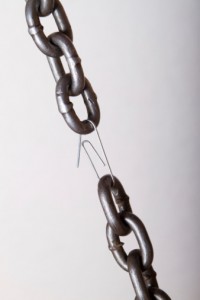The Power of Networks (Part 4)
By Asher Crispe: January 31, 2013: Category Inspirations, Networks of Meaning
 When sociologist Mark Granovetter published his 1973 paper entitled The Strength of Weak Ties there was no telling how just influential it would become. Today, with tens of thousands of citations in other scholarly works, Granovetter’s work put forth one of the most pivotal distinctions regarding the growth of networks. Assuming that we all want to become connected, the question becomes how? What is the fastest and most efficient way to increase one’s network? It turns out, according to Granovetter, that the key growth factor for connecting nodes with links (or in social terms: putting one person [node] in touch with another [node] so that they may begin a relationship [link]) depends upon the relative strength or weakness of the ties.
When sociologist Mark Granovetter published his 1973 paper entitled The Strength of Weak Ties there was no telling how just influential it would become. Today, with tens of thousands of citations in other scholarly works, Granovetter’s work put forth one of the most pivotal distinctions regarding the growth of networks. Assuming that we all want to become connected, the question becomes how? What is the fastest and most efficient way to increase one’s network? It turns out, according to Granovetter, that the key growth factor for connecting nodes with links (or in social terms: putting one person [node] in touch with another [node] so that they may begin a relationship [link]) depends upon the relative strength or weakness of the ties.
To grasp the essential difference between strong and weak links, we can think of a circle of close friends and family. Most of us know many of the same people as others who run in our immediate social circle. Having grown up in a small Vermont town, it was clear to me that most people knew most people in the area. Some of the smaller villages in Vermont might only have a couple hundred residents so it becomes increasingly likely that everyone is well acquainted. Even when the population increases, we still love playing social geography games for the simple reason that we might know people in common or be related in some way. My mailman is neighbors with my first grade teacher whose grandmother used to babysit my accountant who is the brother of my best friend’s horse trainer who summers in Alaska with your sister and so on.
The smaller the group, the more likely that I might know a person via several other common friends, which is to say that we have a strong link between us. Whenever you are dealing with a close knit group or a localized small cluster of people, there will tend to be multiple redundant connections between them. A ‘strong link’ implies a high density of bonds between the group, as is the case when our social circle has each of us interrelated four or five different ways.
The problem when we all know the same people is that we never get connected outside our social circle. Ever tried asking for connections that might lead to a job and found everyone recommending to you the same people over and over again? If you have then you already grasped the issue. John tells Ted to go to Mark, but Ted has known Mark for years and spoke with him yesterday about a job. So Ted moves on to try his next friend Bill who also suggests that he speak to Mark. Now, Ted is getting frustrated that he already tried that avenue without success. Not one to easily give up he calls Kevin who, after some brief brain storming, says that he’s got the solution which is that Ted should speak with John. Ted tells Kevin that he already went to John who shuttled him on to Mark who didn’t have any openings. Kevin scratches his head and confirms what everyone has already said, which is that Ted should speak to Mark, but since Ted has already spoken to Mark he is at a total loss.
Such all too familiar merry-go-round referrals keep happening because all of these people know each other. Thus, the tendency is to simply pass Ted along to someone he has either already spoken to or has been suggested to speak to. The only way to break out of this ‘vicious cycle’ is to try to develop ‘weak links.’ Weak links are formed whenever you take a trip someplace new, whenever you go outside your comfort zone of friends, family and acquaintances, whenever you hop from your local group to a non-local group of people.
We have all had the experience of heading out of town and standing in line at the train station or sitting beside someone on a flight and striking up a conversation. The total stranger we end up conversing with might be from another state, country or continent from you and live in a place that you’ve never heard of with and abundance of friends that you would never have had access to had you not bumped into each other during your journeys and exchanged business cards or emails. Suddenly someone from a small town in Vermont is connected through this single link to another cluster of people on the other side of the world. This newly established connection is considered ‘weak’ in that you know none or few of the same people. Now your network can now really grow. The wider you cast your net the more people are likely to fall into it. The more you travel, the more you visit places that you otherwise would never go, the more exchanges with strangers, the more rapidly our number of links will shoot up.
This distinction between strong and weak links is anticipated within Chassidic thought. The Lubavitcher Rebbe (Rabbi Menachem Mendel Schneerson) was a great theoretician and practitioner of the science of networks who qualified the redemptive process (the global network formation that arouses the messianic consciousness of us all being connected) as the propagation of weak links. In his expression, Moshiach (the Messiah) does not come on a ‘steel bridge’ (gesher shel barzel). If someone is only willing to walk on a steel bridge it is because that person has risk adversity and wants to play it safe. Obviously bridges connect nodes which means that a steel bridge would be the equivalent of a strong link. Sociologically this would mean staying within the confines for what you already have known and have tested. It signifies the group tendency to remain insular. When we have a community of like-minded individuals or special interest groups that enjoy that same things or share a common set of beliefs, then the social bonds are fortified by this redundancy and homogeneity.
On the other hand, if the desire is to reach everyone far and wide, to relate to a diverse crowd of people who may or may not see eye to eye, then it is a question of venturing beyond the familiar. The stability of the bridge is untested. Rather than the Brooklyn bridge which you and millions just like you have driven over millions of times, we come to a swaying rope and plank bridge deep in the jungle spanning precariously over a 1000 foot fall into a gorge below. Having never watched another person successfully traverse this rickety old thing that was clearly not designed by the army core of engineers, we may hesitate to cross it. Will it support our weight or will it collapse at any moment? When it comes to investments (especially personal investments where I bear the brunt of the fall out and stand to lose the most) I might only want to bet on a sure thing. This would be similar to insisting on the tried and true–steel bridges alone will suffice. But how many steel bridges already exist? They are only built on the familiar roads leading to familiar territory. They don’t afford me the opportunity of blazing a new trail, of putting in a connection where no connection has ever been. Alternatively, high risk leads to big rewards. A person’s capacity for mesirut nefesh (literally self-sacrifice or ‘giving over’ of self) really amounts to a willingness to take risks.
 The global redemption is predicated upon going out of our way to build new bridges– bridges which are untested and involve substantial personal risk. Every time I travel outside of my social circle or outside of the familiar and introduce myself to a stranger, I am walking on a non-steel bridge. When I to try to relate to the other, to the one who is not like me, I am working to construct weak links. To accomplish this, either I myself need to go out and travel the world or I need to send some representative on my behalf to travel for me or I need to have a virtual link that puts me in contact with the other and with the outside via telepresence technologies. Sociologically speaking, the first exodus is going out of myself (getting beyond my fear of the unknown) to the other. On the same note, the final exodus would be to completely transcend the qualitative and quantitative limitations of the connections. Everyone and everything joins the network. Weak links are then converted into strong links.
The global redemption is predicated upon going out of our way to build new bridges– bridges which are untested and involve substantial personal risk. Every time I travel outside of my social circle or outside of the familiar and introduce myself to a stranger, I am walking on a non-steel bridge. When I to try to relate to the other, to the one who is not like me, I am working to construct weak links. To accomplish this, either I myself need to go out and travel the world or I need to send some representative on my behalf to travel for me or I need to have a virtual link that puts me in contact with the other and with the outside via telepresence technologies. Sociologically speaking, the first exodus is going out of myself (getting beyond my fear of the unknown) to the other. On the same note, the final exodus would be to completely transcend the qualitative and quantitative limitations of the connections. Everyone and everything joins the network. Weak links are then converted into strong links.
In Part Five will assess the additions factors in our network connections such as the width of the bridge.
http://www.interinclusion.org/inspirations/the-power-of-networks-part-5/
http://www.interinclusion.org/inspirations/the-power-of-networks-part-3/




















;)
;)
;)
;)
;)
;)
;)
;)
;)
;)
